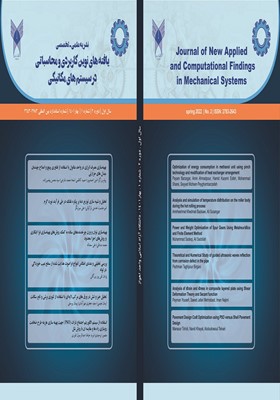Analysis of strain and stress in composite layered plate using shear deformation theory and secant function
Subject Areas : Journal of New Applied and Computational Findings in Mechanical SystemsIman Najimi 1 , Saeed Jafari Mehrabadi 2 , Peyman Yousefi 3
1 - Department of Mechanical Engineering, Islamic Azad University, Arak Branch, Arak, Iran
2 - Department of Mechanical Engineering, Islamic Azad University, Arak Branch, Arak, Iran
3 - Department of Mechanical Engineering, Islamic Azad University, Arak Branch, Arak, Iran
Keywords: secant function, Layered composite materials, higher order theory of shear deformation, Hamilton's principle,
Abstract :
The increasing applications of compound materials in various industries, including aerospace, shipbuilding, micro and macro dimensions have, So researcher special attention to the design of these structures. In this study, static analysis of a rectangular plate with the special case of high order correction of shear deformation was investigated by considering the, secant function in spatial change field. In this study, the relation between the changes and the Hamilton's principle has been achieved by forming the different energy term of the system. To solving the governing equations, the Navier - stokes equations are implemented using sinusoidal and sinusoidal functions and considering the boundary conditions of the system. By solving the equations, the deflection values of the plates are calculated according to the changes in the system parameters and the obtained results are compared with the results contained in the validated literature and the accuracy of them is sufficient. In conclusion, the bounded analysis with the help of secant functions is very close to the responses obtained from similar researches and in certain cases we can use these functions.
[1] Mindlin, R. (1951). "Influence of rotatory inertia and shear on flexural motions of isotropic, elastic plates."
[2] Reissner, E. (1985). "Reflections on the theory of elastic plates."
[3] Ambartsumian, S. (1958). "On the theory of bending plates." Izv Otd Tech Nauk AN SSSR 5(5): 69-77.
[4] Soldatos, K. and T. Timarci (1993). "A unified formulation of laminated composite, shear deformable, five-degrees-of-freedom cylindrical shell theories." Composite structures 25(1-4): 165-171.
[5] Reddy, J. N. (1984). "A simple higher-order theory for laminated composite plates."
[6] Touratier, M. (1991). "An efficient standard plate theory." International journal of engineering science 29(8): 901-916.
[7] Karama, M., et al. (2003). "Mechanical behaviour of laminated composite beam by the new multi-layered laminated composite structures model with transverse shear stress continuity." International Journal of solids and structures 40(6): 1525-1546.
[8] Soldatos, K. (1992). "A transverse shear deformation theory for homogeneous monoclinic plates." Acta Mechanica 94(3): 195-220.
[9] Aydogdu, M. (2006). "Comparison of various shear deformation theories for bending, buckling, and vibration of rectangular symmetric cross-ply plate with simply supported edges." Journal of Composite materials 40(23): 2143-2155.
[10] Swaminathan, K. and S. Patil (2008). "Analytical solutions using a higher order refined computational model with 12 degrees of freedom for the free vibration analysis of antisymmetric angle-ply plates." Composite structures 82(2): 209-216.
[11] Liu, L., et al. (2007). "Mesh-free radial basis function method for static, free vibration and buckling analysis of shear deformable composite laminates." Composite structures 78(1): 58-69.
[12] Wu, C.-P. and W.-Y. Chen (1994). "Vibration and stability of laminated plates based on a local high order plate theory." Journal of sound and vibration 177(4): 503-520.
[13] Cho, K., et al. (1991). "Free vibrations of laminated rectangular plates analyzed by higher order individual-layer theory." Journal of sound and vibration 145(3): 429-442.
[14] Plagianakos, T. S. and D. A. Saravanos (2009). "Higher-order layerwise laminate theory for the prediction of interlaminar shear stresses in thick composite and sandwich composite plates." Composite structures 87(1): 23-35.
[15] Aydogdu, M. (2009). "A new shear deformation theory for laminated composite plates." Composite structures 89(1): 94-101.
[16] Pagang, N. and S. J. Hatfield (1972). "Elastic behavior of multilayered bidirectional composites." AIAA journal 10(7): 931-933.
[17] Idlbi, A., et al. (1997). "Comparison of various laminated plate theories." Composite structures 37(2): 173-184.
[18] Kaczkowski Z.Plates-statistical calculations. Warsaw: Arkady ; 1968
[19] Levinson, M. (1980). "An accurate, simple theory of the statics and dynamics of elastic plates." Mechanics Research Communications 7(6): 343-350.
_||_

